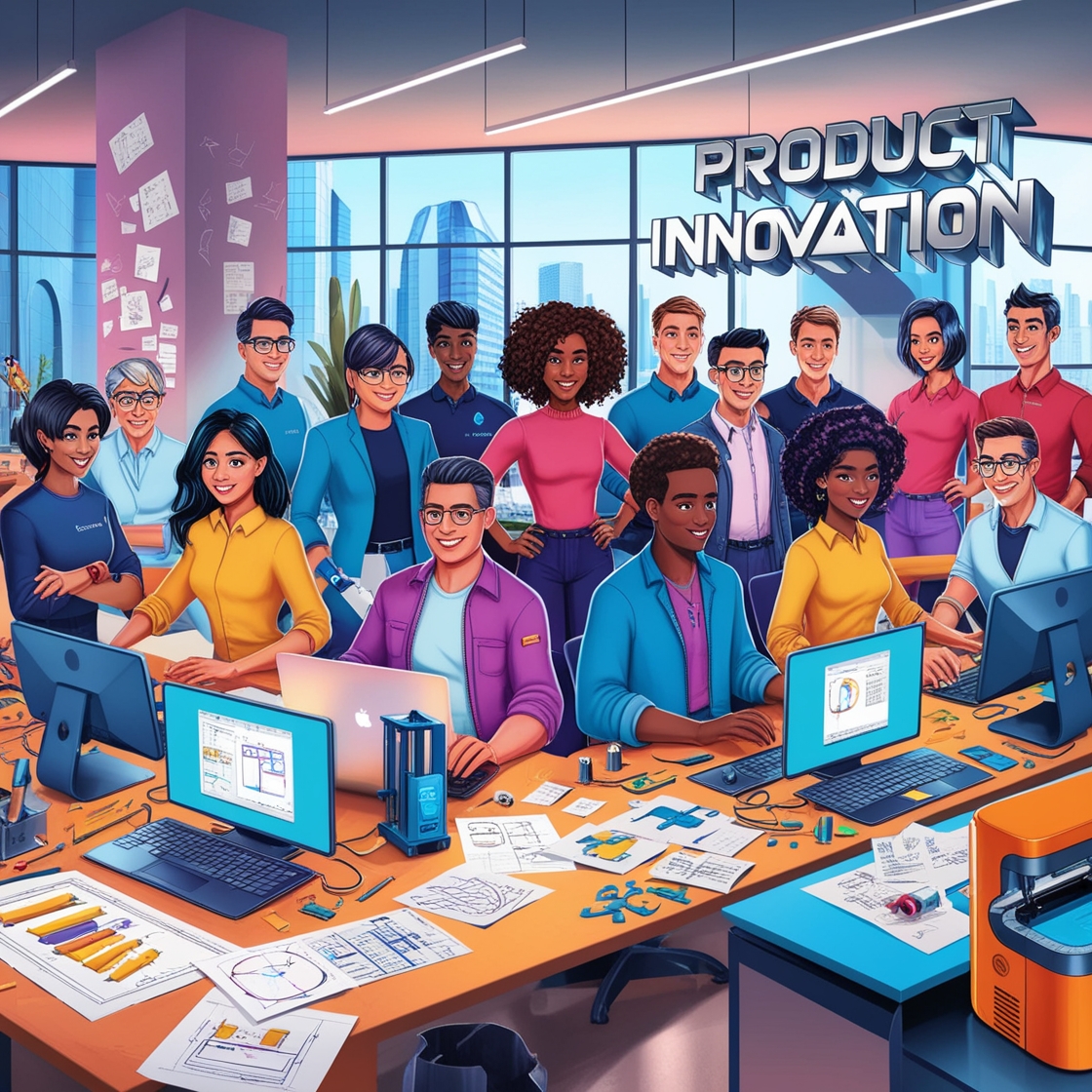What is Industrial Design and Its Importance
More Than Beauty: The Whole Picture
The Intersection Between Art, Science and Business
Core Competencies and Skills
The Innovation Process
Research and Discovery
Problem Identification
Idea generation and concept formation
Prototyping and Testing
Design Implementation
Impact on Product Development
User Experience Enhancement
Manufacturing Optimization
Sustainability Integration
Cost Efficiency
Market Differentiation
Collaboration and Integration
Collaborate with engineering teams
Business Strategy and Marketing Business Strategy and Marketing
Manufacturing Partners
End-User Feedback
Sustainability Experts
Future of Industrial Design
Emerging Technologies
Sustainable Design Practices
Global Market Considerations
Industry Trends
And now we are writing that detailed article:
Product Design and the Importance of Industrial Designers
Industrial designers can be said to be the unsung heroes in product management, acting as go-betweens for user need and what is possible human/technology-wise. When it comes to innovation, their function is much more than just making things sumptuous; they contribute to developing solutions that change our lives or how we perform tasks.
What is Industrial Design?
From Its Aesthetic to Its Total Landscape
Product Development for Industrial designers through:
Analysis of user experience research
Human factors and ergonomic considerations
Selection and optimization of materials
Innovation in the manufacturing process
Sustainability implementation
Developing solutions that cost less
For, their work touches every part of product creation and usage.
Merging Art, Science, and Business
Industrial designers today are hybrids of:
Ability to think creatively to develop innovative solutions
Application of Technical Knowledge and Engineering Principles
Business and market understanding
Environmental awareness
Social responsibility
Manufacturing expertise
This blend of expertise allows them to lead innovation successfully.
Core Competencies and Skills
Essential skills include:
Sketching and visualization
3D modeling and CAD
Knowledge of Materials Science (understanding mat.
Knowledge of manufacturing processes
Project management
User research methods
Prototyping techniques
The Innovation Process
Research and Discovery
This is where industrial designers start:
User behavior analysis
Market research and trends
Competitive product analysis
Technology assessment
Environmental impact studies
Research on how cultures consider things
This foundation guarantees innovations meet genuine needs.
Problem Identification
Designers excel at:
Identifying user pain points
Recognizing market gaps
Anticipating future needs
Understanding usage contexts
Analyzing product lifecycles
Recognizing issues related to sustainability
This leads to meaningful innovation.
Concept Development and Ideation
The creative process consists of:
Brainstorming sessions
Sketch development
Concept modeling
Material exploration
Function analysis
User scenario development
Prototyping and Testing
Designers utilize:
— Technologies for Rapid Prototyping.
User testing procedures
Iterative design processes
Performance evaluation
Ergonomic testing
Durability assessment
Design Implementation
Final stages involve:
Manufacturing optimization
Material specification
Assembly process design
Quality control standards
Packaging design
User manual development
Impact on Product Development
User Experience Enhancement
Designers enhance user experience via:
Intuitive interface design
Ergonomic optimization
Accessibility considerations
Emotional connection creation
Usage simplification
Safety implementation
Manufacturing Optimization
Manufacturing innovation includes:
Improvements to process efficiencies
Assembly simplification
Material usage optimization
Quality control enhancement
Cost reduction strategies
Production scalability
Sustainability Integration
Environmental considerations are proposed includes:
Recyclability oriented material selection
Energy-efficient design
Waste reduction strategies
Lifecycle assessment
Maintenance and repair planning
End-of-life considerations
Cost Efficiency
Designers play important roles in cost optimization through:
Material selection efficiency
Simplifying the manufacturing process
Assembly time reduction
Packaging optimization
Transportation efficiency
Maintenance cost reduction
Market Differentiation
Products stand out through:
Unique design solutions
Brand identity integration
User-centered features
Innovation implementation
Quality perception
Value proposition enhancement
Collaboration and Integration
Collaboration with Engineering Teams
To collaborate successfully, there is:
Discussion of technical feasibility
Design input for manufacturability
Performance optimization
Coordination of material selection
Testing protocol development
Problem-solving partnerships
Business and Marketing Strategy
Designers will align with business objectives by:
Brand alignment
Market positioning
Product storytelling
Value proposition development
Competition differentiation
Launch strategy support
Manufacturing Partners
Collaboration includes:
Process optimization
Quality control standards
Cost reduction strategies
Production timeline planning
Tool design input
Material sourcing assistance
End-User Feedback
Designers facilitate:
User testing sessions
Feedback collection
Behavior observation
Preference analysis
Usage pattern studies
Improvement identification
Sustainability Experts
Partnership focuses on:
Reductoion in Environmental Impact
Material selection guidance
Energy efficiency improvement
Lifecycle assessment
Waste reduction strategies
Circular economy integration
Future of Industrial Design
Emerging Technologies
Designers embrace:
Integration with Artificial Intelligence
Virtual reality tools
3D printing advancement
Smart material development
Connectivity of things on the internet
Augmented reality apps
Sustainable Design Practices
Future focus includes:
Implementation of a circular economy
Biodegradable materials
Energy-neutral products
Waste elimination
Resource optimization
Environmental protection
Global Market Considerations
Designers address:
Cultural preferences
Regional regulations
Native manufacturing capabilities
Market-specific needs
Distribution challenges
Price point requirements
Industry Trends
Emerging trends include:
Customization capabilities
Connected product ecosystems
Sustainable solutions
Inclusive design
Modular systems
Service integration
Conclusion
Industrial designers hold a central role in product innovation, bridging user needs, technical capabilities, and business needs. Industrial designers are equally creative to see the product within students capable of seeing the non-functional aspect of a product and being able to produce it and that’s why they’re so important if a thing isn’t manufacturable it will never see the light of day and so with everything above a job for industrial design comes full circle.
FAQ
How long does it take for the industrial design process? Depending on product complexity, this timeline varies significantly, yet generally spans from 3-12 months from concept to production-ready design.
How does industrial design differ from product design? Although they overlap, industrial design typically has a greater emphasis on manufacturability and mass production, whereas product design can include digital and bespoke products.
What is the balance of aesthetics and functionality for industrial designers? Designed through an iterative lens as well as tested thoroughly, aesthetic choices are made in a way to support and enhance functionality rather than sacrifice it.
How important are industrial designers for sustainability? They play a big role in establishing sustainable practices using material selection, design for disassembly, lifecycle consideration and waste minimization strategies.
What is the working relationship between industrial designers and engineering teams? They work closely with engineering throughout the development process to balance innovative designs with technical feasibility and manufacturing requirements.
